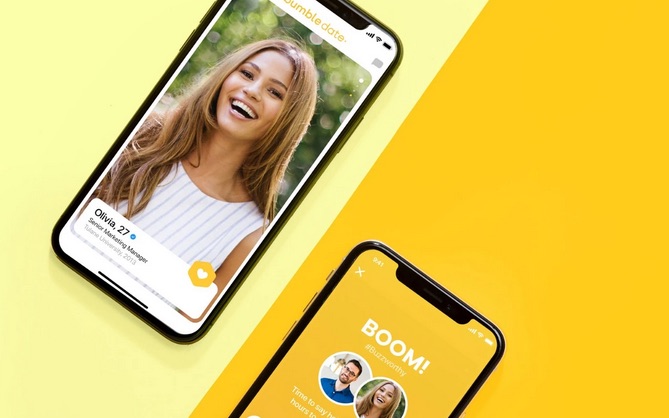As with any major life decision, before diving into the intimidating and confusing world of dating apps, it’s a good idea to do a little research. Two giants have long dominated the land of matches: Tinder and Bumble. Although similar in their fundamental concepts (making a snap judgment about a series of strangers by swiping right for “yes” and left for “no”), each is unique in its approach.
There’s no limit on the number of dating apps you can download and use, of course, but everyone does seem to develop a favorite. Want a head start on picking a preference? We’ll help you see the differences between the two biggest and most popular, Tinder and Bumble, to bring you one step closer to finding your soulmate. If you want to see what else is out there, check out the best dating apps for 2020.
What is Tinder?
Tinder definitely laid the groundwork for its predecessors to adapt and improve upon. If you’ve ever used a dating app for more than an hour, you’ll probably have developed an intriguing set of new brain functions: The ones that allow you to know, with some degree of positivity, whether you find someone’s profile appealing after a 10th of a second. You can thank Tinder for that.
Although it varies across the country, sexual preference, and age group, there are two aspects of Tinder that consistently ring true.
Tinder has a lot of options (for women)
You’ll find about half as many women on Tinder as there are men. If you’re female, this is either a good or a bad thing, depending on how you look at it. On the one hand, it means more choice, and more choice means more opportunities to find Mr. Right (if you’re looking for a mister, that is).
On the other hand, it can mean swiping through a lot of frogs before finally matching with a prince. Equally, the gender imbalance can make for a rather intimidating environment, which leads to our second point.
People tend to look for hookups on Tinder
Although not a universal truth, it is generally more common on Tinder than on Bumble to be approached for a, shall we say, short-term engagement. This does make it easier to cut to the chase if that’s what you’re looking for from a dating app. Of course, you can now video call your Tinder matches within the app, too.
Expect more outreach (if you’re a woman on Tinder)
Perhaps it has something to do with there being twice as many men on Tinder, but plenty of women say they are approached far more frequently by men who don’t appear shy about making the first move or offering a rather direct proposition. So, be prepared for some eye-watering upfront pickup lines.
What is Bumble?
Bumble, the first real contender to Tinder’s heavyweight title, succeeded because it addressed some of the less-appealing aspects of its competitor. It paved the way for a new generation of dating apps by aiming to level the gender playing field and make the whole experience a little nicer.
Bumble: Leveling the land
Bumble has a roughly equal ratio of male to female users, and the female has to be the one to make the first move after a match. This encourages women to be more considerate with their swiping and only “like” someone with whom they’re actually prepared to start a conversation. The general ambience of Bumble is definitely geared towards quality over quantity of matches.
Women have to talk first on Bumble
The rule of thumb with Bumble is the ladies make the first move, and that’s not just a mantra, it’s a necessity. If a woman wants to get into the game, she must initiate the first contact on Bumble. That makes a lot of women feel more in control and less concerned about finding unsolicited offers in the old inbox.
Bumble matches disappear after 24 hours
Bumble helps you out by linking you with someone else who has also swiped right on your profile, but there’s a catch designed to initiate action and minimize the internal debating: If you don’t strike up a chat with your match within one day, it will be lost forever. This is kind of a double-edged sword. On the one hand, it makes for a more proactive experience, but it also means you have to be vigilant to ensure the potential love of your life doesn’t disappear into the digital void.
Bumble gets you to share more about yourself
By far, one of the best features of Bumble is that when you’re creating your profile, it asks you to provide lots of info about yourself, such as your height, whether you smoke, and what you’re looking for from the app. It even lets users filter their choices according to these criteria. What’s more, it prompts users to answer questions about themselves like, “Netflix or nightclub?” and “What’s your best travel story?” This generally increases the chances of matching with someone who you’re actually going to get along with.
Bumble offers friends and business connections, too
Bumble has taken its deeper connections and put its money where its app is, creating Bumble BFF and Bumble Biz for making platonic friends and business relationships. The company seems invested in helping you find lasting relationships, no matter what kind of connection you want to make.
When it comes to Tinder versus Bumble, it’s like looking at two sides of the same coin. You can dip your toe into the veritable ocean of single people on Tinder, put in a lot of swiping effort, and hopefully find a match fast. Alternatively, you can set out your preferences, curate your profile, and dive into the smaller dating pool of Bumble, where matches are less frequent but more promising. But there’s no rule saying you can’t maintain profiles on both sites simultaneously. Isn’t that the very definition of playing the field?





